| |
| MAGAZINE
|
 |
| Contemporary
Artists
|
 |
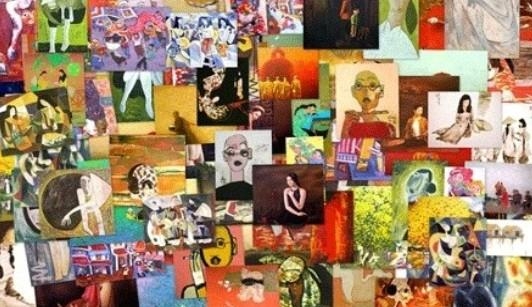 |
 |
|
Digest |
| |
 |
|
| --Most
artists would rather cut off their right arm (... or their ear
off !!!), then engage in the entrepreneurial dance that Artcity21
call "SELLING".
--For
many artists, that's because trying to make a deal feels like
an uncomfortable means to an end.
--But
selling your art doesn't have to be forced and awkward. Artists
can develop a sales cycle that fits their personality and isn't
offensive to the buyer using these C's.
--Confidence,
Conversation, Community.
--Confidence
is imperative for success. If you want to be successful you must
be willing to do things that put yourself out there as an artist
and an entrepreneur.
--So
on a scale of 1 to 10, how would you rate your confidence level
as an artist?
--It
may be best to rate yourself in each of the following categories
and then take an average "Go Ahead, Do It Now".
--Artistic
creativity and Vision. Technical ability. Marketing and Promotion.
Closing the sale.
--Whatever
your score is now, that's the baseline to measure your progress.
--If
you are able to increase your confidence by one point in each
category, what would that look like? How would it manifest when
you engage your ideal customer?
--Remember,
you control your confidence level.
--True
confidence comes from an internal choice, not from external elements...
that spin your confidence around like a weather vane in windstorm.
--Become
committed to yourself and your art. Choose to be confident. People
are always amazed to learn that you are not only the sales person,
but the creator of the work as well.
--They
are in awe twice over, so leave your fear behind - They are more
intimidated by your talent than you are of selling!
--Soak
up those good vibes and claim your work and your life as an entrepreneur.
|
| |
| |
 |
| --How
can something as simple as conversation be an effective sales
tool?
--When
you come in contact with a potential customer you'll naturally
engage in a relationship ritual known as courting. What you need
to realize is that potential customers want to know you so that
when they show your work to friends, family and colleagues, they
will be able to tell your story.
--Therefore,
your conversations should include your story, the essence of your
brand. You will want to leave your customers with a strong idea
of who you are, every time.
--Artcity21
is not suggesting that all your future conversations be scripted
- conversation is an Art by itself - but we would recommend Debra's
Fine's "The Fine Art of Small Talk" if you want extra
help in this regard.
--Her
tips will give you the edge you need to invite prospects to keep
your customer happy.
--Think
of your sales process as a lively conversation, at a cocktail
diner, for example, not a chore - it should be fun for both you
and them!
--COMMUNITY
- Ever wonder why the airlines create a club rooms and special
lounges for loyal customers?. -They
do it to build a sense of community.
--Art
buyers like to feel as if they are part of your inner circle -
AND THEY SHOULD BE!
--So
make them feel that way as part of your sales cycle. There are
many ways to do it.
--Show
your customers that they are part of your "inner circle"
community through personalized invitations to openings and events.
--Have
an annual function for collectors only.
--It
doesn't have to be at the Ritz, why not invite them to your studio?
--Or
set up a private showing. People always like to be invited to
pass through the velvet ropes, like a VIP Lounge.
--Sales
don't have to be difficult or tedious. If you use these tutorials
you can easily create a sales process which fits your personality
and your market, and encourages art buyers to purchase again and
again.
|
 |
| |
 |
| --If
you are like most artists, you probably live and work with artists,
eat with artists, socialize with artists and recreate with artists
- and likely with other fine arts professionals as well. --And
when you are on your own, you probably read about artists, visit
art websites, and attend art lectures, galleries, museums, and
more. You are basically all Art all the time.
--And
that's excellent!
--But
if you want to maximize your chances for success as an artist,
you've got to do more. What kind
of more? You have to continually broaden your horizons, or in
other words, learn how to present your Art to a progressively
wider and wider variety of people in a wider and wider variety
of circumstances.
--You
see, the problem with the All-Art-all-the-time lifestyle is that
the more inside the beltway you are, the more removed you tend
to be from typical everyday people who like Art, but who may not
know much about it.
--There's
plenty of them out there, believe me.
--And
when presented with everyday opportunities to talk about your
Art with everyday people outside the Art-O-Sphere, the more you
risk lapsing into pretentious Art prattle and rapidly rendering
any such interested parties ... COMATOSE!
--The
worst part about these casualties of incomprehension is that given
ideal conditions, some of them may have turned out to be buyers.
--Think
about this. Anyone who is interested enough in your Art, no matter
who they are, to take time out of his or her harried life to stop
and look at it, and ratchet up the scrotumnal fortitude to ask
you about it, has to be considered a potential buyer - not immediately,
of course, but assuming your impending interaction proceeds in
ways that increasingly engage them with either you, your Art,
or both.
--The
TRICKY part?
--Doing
this without intimidating, insulting or overwhelming them, or
God forbid, frightening them away.
--This
is not easy - having a casual encounter evolve into a sale - but
it is possible.
--And
the better you get at guiding inquiring minds through perilous
intellectual thicket surrounding your Art, the greater the number
of sales you will ultimately make.
--The
EASY part?
--You
already know how to talk about your Art with art people. No problem
there. You understand each other perfectly. That's take care of.
--The
HARD part is learning to talk to everybody else ( aka the other
99% of the population, pretty much all of whom like Art ).
--The
SAD fact is that most artists don't have clue number one about
how non-art people respond to their Art ( or how to respond back
... ).
--The
DUMB fact is that many of these artists don't even care about
that 99% ... and dismiss them as irrelevant.
--Perhaps
they see no up side in terms of personal advancement, they enjoy
the perks of elitism, they regard confusing the hell out of people
as an ego wonk, or whatever.
--The
one minor detail they overlook?
--Profit
potential.
--You
see, at some point you have to think about buyers - those blessed
individuals who may actually pay money for the Art you create,
each and everyone of those paydays enhancing your chances of making
your living making Art.
--And
the greater range of buyers you pay attention to, the greater
the opportunities to expand your client base, and the greater
the probability of your surviving as an artist.
--Who
these people are and how little or much they know about Art makes
absolutely no difference - as long as they buy.
--And
since nobody buys anything they don't understand, it behoves you
to acquire the skills to effectively present your Art to as wide
a variety of people in as wide a variety of circumstances as possible.
|
 |
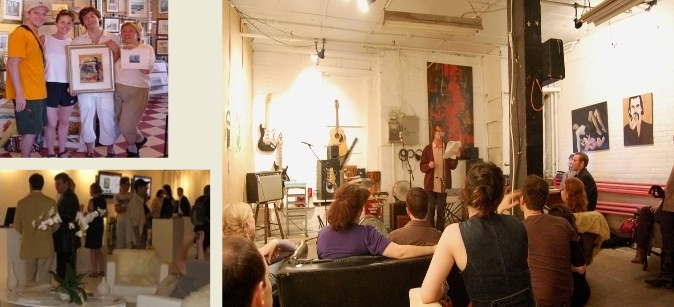 |
 |
| --The
Goal !
--Understanding
how different kinds of people respond to your Art so that you
can learn to respond to their response.
--THE
METHODOLOGY?
--You
do what's commonly called "Market Research", or put
another way, you watch people respond to your Art, and most importantly,
talk to people about their responses to your Art. Let us explain.
--The
more you know about how your Art affects people, and about what
types of information they need in order to maximally appreciate
and enjoy it, the better able you are to keep those people in
the game, to hold their attention, to keep them asking questions,
to progressively deepen their experiences, and hopefully, to make
sales or get shows or whatever else you are looking for.
--REMEMBER!
- we are focusing on typical everyday people who like Art, not
art people.
--You've
already got art people covered.
--The
most important people for you now are those you know the least
about, those you have been ignoring, for whatever reasons, or
those you have made assumptions about, but have never bothered
to test whether those assumptions are the least bit accurate.
--How
do you gather the necessary data?
--One
of the best ways is to host a show or soiree or reception or party
or gathering around your Art.
--Better
yet, have someone host it for you. Contact people you know and
ask if they will help you out, especially those outside the art
world. Hopefully someone will offer or have access to a space.
Then again, if you have to do it all yourself, that's fine too...
as long as you do it.
--Hold
your event in a non-intimidating location, like a private home
or apartment, common area of a building, meeting room, specialty
store, or lobby.
--Not
an Art Gallery or Art Studio or place where art people hang out,
but preferably some neutral area where non-art people generally
feel comfortable.
--That
way, they will have their guards down and be more likely to respond
to what they see and to communicate their experiences. And make
sure there's no pressure to buy, just to come, look, enjoy, have
fun. Then again, if someone wants to buy something, go for it.
--Invite
as many non-art people and as few art people as possible, also
minimizing friends, family, and those who already know your Art
- they won't be any help.
--In
fact, they will distract you from the matter at hand.
--Encourage
those you invite to invite friends they think might be interested,
and for those friends to invite their friends.
--The
goal is to get total strangers through the door - people who have
nothing invested one way or another in either you or your Art.
Save your fan base later.
--Remember,
this is not about people you know; it's about people you don't
know.
--Sure,
you'll probably feel awkward, but that's exactly the point. You
are here to learn, and in order to do that, you have to get brave
and explore unexplored territories.
|
 |
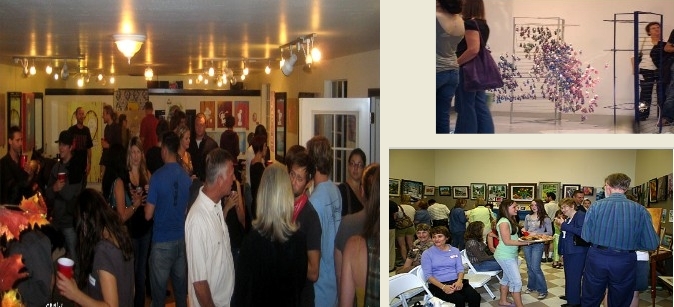 |
 |
--You
see, since most artists have no idea how typical people respond
to their Art, they don't know how to speak about their Art in
language those people can understand.
--Pretty
much everybody likes Art, and they have all kinds of questions
about it, many of those questions unrelated to any formal aspects
of Art or Art History, questions like how long it takes to make,
how much it weighs, how hard it is to move, what you hang it with,
what it means, why you put the red circle in the corner, how long
it takes to dry, and so on.
--Most
importantly, people who don't know that much about Art questions
you don't anticipate, some of which will be so off the wall they
will take you totally by surprise, some so totally you won't have
the slightest idea how to respond.
--A
surprise question can only surprise you once, and once the surprise
is over, it's time to craft an answer. Why? Because hardly anything
is worse than saying nothing or "I don't know ".
--And
this is the key - Learning to respond to all kinds of questions
from all kinds of people. Experienced artists are good at this;
many are so good, they make preemptive strikes on a wide variety
of questions before they even get asked.
--Remember,
no matter how uninformed or irrelevant certain questions may sound
to you, we can assure you that they are of utmost importance to
the people who ask them, and furthermore, that your answers are
critical to advancing the discussion, so critical in fact that
some of those answers may ultimately lead to sales.
--THE
MORAL OF THE STORY?
--In
order to effectively transit artland and survive as an artist,
you are required to answer all kinds of questions about yourself
and your Art from all kinds of people all the time - quick, credible,
compelling, easy to understand, and most importantly, with respect.
--Your
mission is to give people a grip, to get them involved, and once
you master that, you are on your way. --The
better you are at getting people confortable around your Art,
the better your chances of succeeding as an artist.
--It's
that simple and no more complicated.
--ADDITIONAL
TIPS - Have several confederates attend your event, listen to
people talk about your Art, perhaps even get involved in the conversations.
Then have them report back to you when it's over.
--Whenever
possible, either at your event or elsewhere, encourage people
to talk with you about their responses to your Art. If they ask
why, tell them their feedback helps you explain your Art in ways
that anybody can understand.
--Pay
attention to the most common questions people ask about your Art.
These are the questions you should have the best answers for.
--No
matter what people say, don't take it personally. In fact, learning
not to take it personally is critical to your success as an artist.
--Remember.
These are not Fine Arts professionals; they are people who like
Art and who respond based on their own personal tastes. It's not
always about you.
--If
you can't put an event together, invite interested parties to
some neutral place to look at and talk about with you about Art.
Tell them what you are up to - that your goal is to explain your
Art in ways anybody can understand - and encourage them to be
direct in their responses.
|
 |
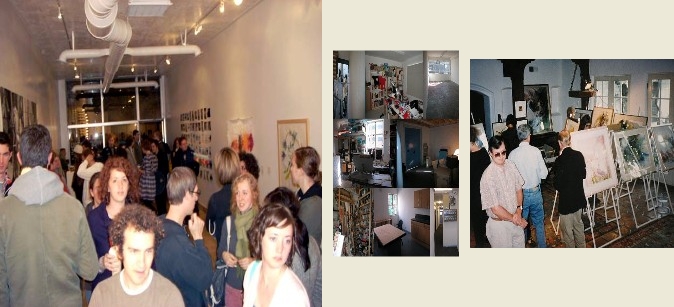 |
 |
--You
are bright, talented, you've got vision, skills, ability, mindset,
and all other necessary ingredients to make your mark in artland.
--In
other words, you are good... real good. The right people are noticing,
the right opportunities presenting themselves, and it's looking
more and more like you are a contender to run the proverbial gamut.
--But
you know what?
--Life
can get pretty precarious out there in the realm, especially when
you are on a roll and everybody is watching, which means that
brushing up on the rules of engagement before you engage, becomes
increasingly essential to you ultimate and hopefully destined
success as an artist.
--You
see, what happens when you become the "Darling du Jour"
is that all of a sudden you get plagued with attention, not only
from those you already know, but you also get rafts of others,
overtures, invitations, galleries, and other entities you know
little or nothing about.
--Sure,
you may recognize some by name, but interacting with them one-on-one,
up-close-and-personal ...is a whole different dealie bob, mainly
because they've got agendas and you are part of them.
--So
what we are going to do here is splay out some basic survival
strategies in order to minimize miscues and expedite your upward
mobility. Ready? Excellent !
--Rule
number one, without question, is to conduct yourself in the Art
world as you conduct your life in general - treat people the way
you expect them to treat you. No matter how fast your career is
accelerating, be polite, courteous, kind, generous, positive,
respectful, attentive, and considerate - every act involving any
of the qualities bodes well for your future.
--In
short, apply all these lessons your parents taught you when you
were young , about how to behave in public and you are 90% there.
It's that simple and no more complicated.
--You
see, a key aspect of career advancement is getting talked about,
and when that talk happens, you want it to be positive, not negative.
--When
people say your name, you want them to say it with reverence and
respect. That's the best way to go by far, and it's the kind of
word of mouth that works for you, not against you.
--The
Art world is small, news travels fast and you want your news to
be good.
--Be
a nice person and work to make people like you - not everyone
will, of course, but at least you know you tried.
--At
the same time, you continue to believe in yourself and in your
vision and being nice at the same time.
--The
upside is that you increase the chances that the right people
get attracted to you and support you. --Benefactors,
patrons, art collectors, art galleries, people to invest in your
future, people who are driven to help artists in their career.
--In
a way you are like a politician. You don't want to have people
around hating you. Go out of your way not to offend - consider
it part of the game.
--Of
course you'll have to deal with downers like jealousy and envy,
but that's the way it goes.
--If
you have to bend over every now and again, so what? Conciliatory
actions are not the worst thing in the world, and best of all,
they come back to you tenfold.
--It
is in your political and financial best interests to cultivate
a social persona that you can use because most people buy Art
and buy into artists in social ways. Take your private life and
personal feelings out of interactions as much as possible. The
instant you start getting annoyed, angry, or offended, things
get complicated.
--To
repeat, don't take it personally, like you are compromising your
artistic integrity - whatever that is - or prostituting yourself
to the whims so the Status Quo.
--It's
business, plain and simple, so lighten up and enjoy the ride.
|
 |
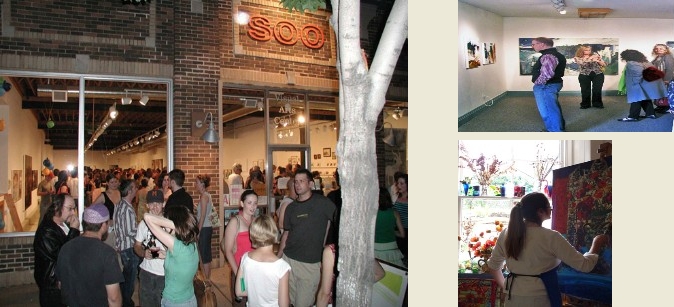 |
 |
|
|
|
|
|
|



